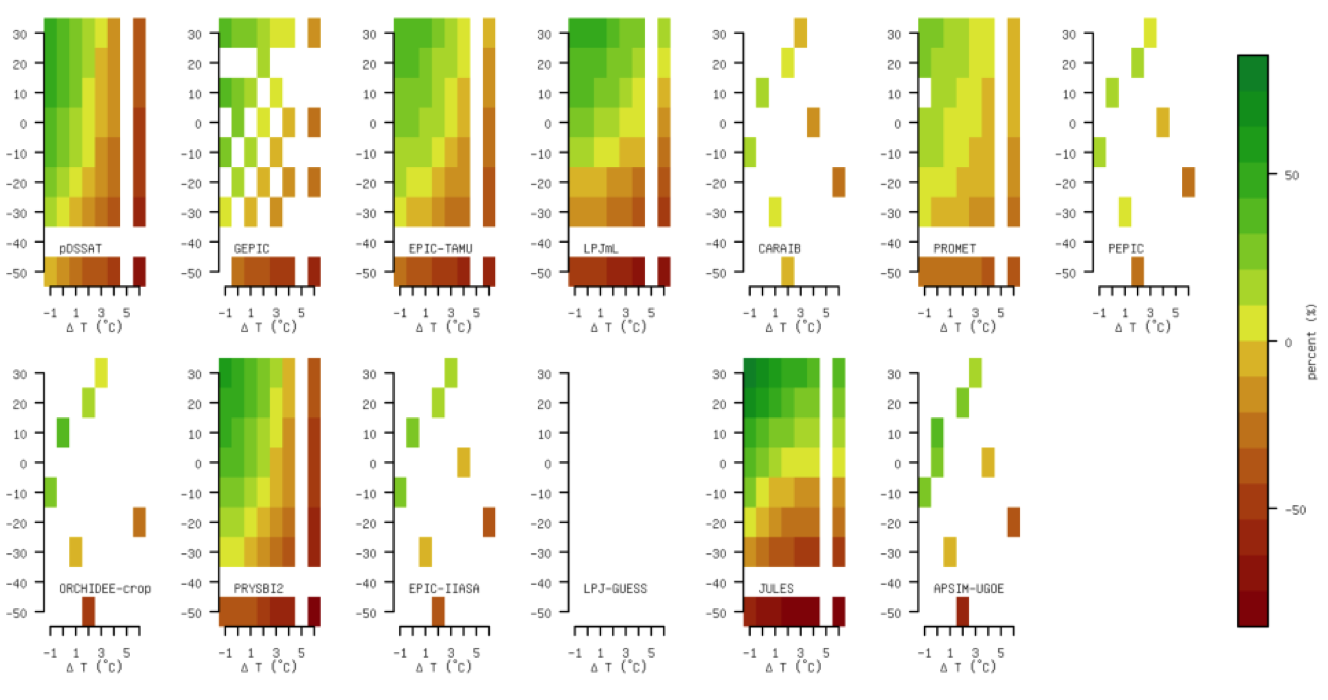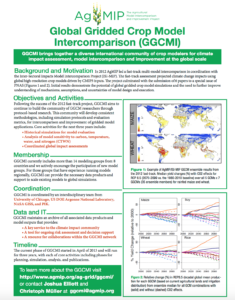Global Gridded Crop Model Intercomparisons (GGCMI)
Main Contacts for Initiative
Joshua Elliott and Christoph Müller
Contact: ag-grid@agmip.org
Brief Description of Activity
After ISIMIP’s fast track in 2012/13, GGCMI conducted a comprehensive historic evaluation phase and followed up with a large input-sensitivity analysis (phase2 ongoing).
Overview of Participants
31 registered modeling groups from around the world, mainly Europe and North America.

Current Research Focus
GGCMI Phase2: large 5-dimensional input sensitivity analysis (CTNW-A) on CO2, Temperature, Nitrogen, Water and Adaptation
Recent Noteworthy Finding
Reports/Papers Submitted/Published soon
Müller: yield variability; Folberth: modeling frameworks; Schewe: heatwave; Wang: field warming vs. models; Wartenberger: AET; Wang: irrigation contribution
New GGCMI Results
Understanding crop model response types in a global gridded crop model ensemble
Background
Global Gridded Crop Models (GGCMs) are increasingly applied for assessing climate change impacts, adaptation, environmental impacts of agricultural production. In combination with integrated assessment or economic modeling they deliver data for projecting future land-use change. Even though global gridded crop models are often based on detailed field-scale models or have implemented similar modeling principles in other ecosystem models, global-scale models are subject to substantial uncertainties from both model structure and parametrization as well as from calibration and input data quality (Müller et al. 2017). AgMIP’s Global Gridded Crop Model Intercomparison (GGCMI) has thus set out to intercompare GGCMs in order to evaluate model performance, describe model uncertainties, identify inconsistencies within the ensemble and (ideally) underlying reasons, and to ultimately improve models and modeling capacities (Elliott et al. 2015).
The CTWN-A Experiment
The CTWN-A data cube: Regular disturbances of 31-year AgMERRA
-
C: 360, 510, 660, 810 ppm (nC=4)
-
T: -1°C to +6°C, skipping 5°C (nT=7)
-
W: -50 to +30, skipping -40 + fully irrigated (nW=9)
-
N: 10, 60, 200 kgN/ha (nN=3)
-
A: regain lost growing season under warming (yes/no)
-
12 GGCMs participated, for up to 5 crops with up to 1404 global 30-year simulations, 7 primary output variables
-
4 GGCMs contributed with small samples only (<100 simulations) and are ignored here (APSIM-UGOE, EPIC-IIASA, ORCHIDEE-crop) for the others, gaps in the data sample (by protocol design (e.g. skipping T=5) or submitting less-dense data samples), have been filled with the GGCM-specific CTNW crop yield emulators (Franke et al., submitted).
References
Elliott et al. (2015): The Global Gridded Crop Model intercomparison: data and modeling protocols for Phase 1 (v1.0). Geosci. Model Dev. 8, 261-277, doi:10.5194/gmd-8-261-2015Franke et al. (submitted to Geosci. Model Dev.): The GGCMI Phase II experiment: simulating and emulating global crop yield responses to changes in CO2, temperature, water, and nitrogen levels
Müller et al. (2017): Global gridded crop model evaluation: benchmarking, skills, deficiencies and implications, Geosci. Model Dev., 10, 1403-1422, doi: 10.5194/gmd-10-1403-2017
Conclusion and outlook
The output data ensemble of the GGCMI CTWN-A simulations is an unprecedentedly rich data base for agricultural analyses with global coverage. Data allow for emulation of model responses (Franke et al. submitted) for application in e.g. IAMs and gap filling. With these data we can distinguish response types in models as well as regions, understanding regional patterns of crop sensitivities to changes in climate. Even though the range of disturbances in the different dimensions are not directly comparable, the structured, protocol-based analysis allows for identifying regional and general model differences that can help to further identify reasons for model disagreement.
The GGCMI CTWN-A data set has been little explored so far. Beyond output data on crop yields, there are several other variables that allow for analyses much beyond what is shown here. Some work is ongoing but more can be done. If interested, please get in touch.
Prior Updates
The GGCMI Initiative brings together a diverse international community of crop modelers for climate impact assessment, model intercomparison and improvement at the global scale.
Background and Motivation
In 2012 AgMIP led a GGCM Intercomparison fast-track project in coordination with the Inter-Sectoral Impacts Model Intercomparison Project (ISI-MIP). This fast-track included 7 GGCMs and focused on updating the state of knowledge on climate change vulnerabilities, impacts, and adaptations using the most current library of climate model outputs (CMIP5). The fast-track culminated with the submission of 6 papers to a special issue of PNAS (see Figures 1 and 2 for example results from that assessment). Starting in 2013, we are developing a new set of protocols for the next phase of the GGCMI, which will focus on data quality, harmonization, model evaluation, and improvement.
Objectives
Build a lasting community of GGCM researchers that will collaborate to perform coordinated global and regional high-resolution impact assessment and model intercomparison studies to improve GGCM applications and our understanding of climate impacts on global food production and regional and temporal variations in these responses.
Membership
The GGCMI includes more than 20 modeling groups from more than 10 countries. We encourage new model groups to get involved in the project. For those groups that only have experience running models regionally, the project can provide the necessary data products and support to scale their existing frameworks up to global simulations.
Coordination
The GGCMI is being coordinated by a team from the University of Chicago and Argonne National Laboratory (ANL) Computation Institute, the NASA GISS Climate Impacts Group, and the Potsdam Institute for Climate Impacts Research. The coordination team will establish a consistent methodology, including simulation protocols and comparison metrics, for intercomparison and improvement of gridded model applications.
Data and IT
The coordination team will also provide access to a database of assimilated gridded environmental, socio-economic, and climate datasets, as well as all outputs and analyses to enable individual and collaborative studies within the GGCMI network. The GGCMI will leverage an existing archive and IT infrastructure developed at ANL to facilitate data sharing and discovery for the 2012 fast-track. This resource, already serving 10 TBs of climate and impact model outputs for the AgMIP and ISI-MIP communities, will be updated and managed as an ongoing resource for the impacts community for years to come.
Timeline
The phase II project will span three years, with the first two years dedicated to model intercomparison, evaluation, and improvement. In the 3rd year, GGCMI participants will undertake a new global assessment of climate change vulnerabilities, impacts and adaptations.

